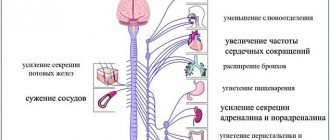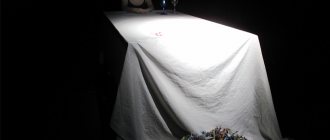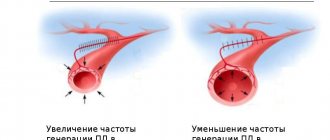Psychologists distinguish two main types of thinking: rational (based on logic) and irrational, the opposite of the first. Irrational thinking people, as a rule, rarely live happily ever after, since they invent problems for themselves that lead to disturbances in the functioning of the autonomic nervous system. The chosen and lost “meaning of life” for such people is synonymous with a real catastrophe, after which existence itself becomes meaningless and joyless. How and why does “blind” attachment to things, circumstances or people become the cause of VSD?
Such different symptoms
Let me start with a cardinal statement: vegetative-vascular dystonia has never been an independent disease.
The complex of symptoms and complaints includes:
- dizziness, headaches, fever;
- feeling of anxiety, fear;
- tachycardia;
- weakness, lethargy, apathy;
- irritability.
Doctors, as a rule, do not find any abnormalities either during examination or in the test results of a person. And accordingly, without identifying any pathology, treatment is not prescribed. At most, these can be vascular or sedative drugs. That is, people who go to the doctor with such symptoms are practically not treated at all.
From jealousy to depression one step
When tying the knot, every woman hopes for “love until the grave.” She gives her husband the main place in her life, often abandoning her own “I”, her desires, goals and needs. Such a “meaning of life” is unreliable, since a man can leave the family at any moment, leaving the woman literally “with nothing.”
Even in marriage, the fear of losing her husband and being alone makes the wife “eat” herself with jealousy. Even a trivial reason (a delay at work or a call from an unknown number) provokes the launch of a whole range of experiences: anxiety, doubt, tossing. An insignificant event “replays” in the sufferer’s head, and she is overcome by obsessive thoughts. As a result, sleep and heart rhythm disturbances, hypochondria and other symptoms of vegetative-vascular disorders appear.
Exam anxiety is natural.
Let's get to the point. The human body is penetrated by the autonomic nervous system, which is divided into two sections: sympathetic and parasympathetic.
The first section enhances the functioning of the nervous system, the second slows it down. And under certain conditions, the body is exposed to either the first or the second sections.
Goose bumps, fever, tachycardia, bradycardia, diarrhea, narrowing or dilation of blood vessels are manifestations of this system. All these manifestations in most cases are the norm and are inherent in every person.
When you take an exam, your palms sweat, when you go out into the cold, you get goosebumps. This is absolutely normal vegetative activity, the cause of which you can attribute to excitement, cold or heat.
Vegetovascular dystonia and its psychosomatics
The nervous system in the human body is the regulator of the activity of all internal organs. It serves as a link between the psychological state and the body. Vegetative-vascular dystonia can hardly be classified as a dangerous disease. But it can deprive a person of joy in life.
Mental disorders have a negative impact on the overall health of every person. The psyche reacts instantly and with special sensitivity to what is happening in the outside world. After this, analysis is carried out. The purpose of the analysis is to determine exactly what decision must be followed, how the body should react, what command should be given to the organs, based on everything that is happening. This is why psychosomatics is so important in VSD.
Weakness for no reason
But when you cannot explain the manifestations of vegetatives, it is worrying. For example, for no apparent reason you begin to feel weak, dizzy, depressed, lethargic. You go to the doctor, but he does not find any pathologies, diagnoses “VSD” and prescribes mild sedatives. That's all. The alarming symptoms continue, you feel frankly bad, but you don’t get treatment because you don’t know how.
The first thing you need to understand is that vegetative-vascular activity, or “vegetative-vascular dystonia,” is a state of emotional disorder, which is called neurosis all over the world.
Ways to combat the manifestations of VSD
Dream
To begin with, it is worth reviewing your daily routine.
You need to train your body to get up and go to bed at approximately the same time. You need to sleep at least 8 hours a day.
But what about insomnia? Insomnia caused by VSD can be well managed by leisurely evening walks in the fresh air, airing the room before bed (a must!), yoga and, oddly enough, stretching. Melatonin in tablets is suitable as a medicinal method; it is a mild, effective and, most importantly, over-the-counter sleeping pill.
- Salad with funchose
- Ear congestion without pain - how to treat. Causes of ear congestion without pain
- Vitamins for the eyes: list and reviews
Another life hack is to sleep with a hot heating pad. The classic VSD sufferer usually has cold feet, which causes discomfort and makes it difficult to fall asleep.
There is a way out - put on soft socks and put a hot heating pad in your feet (no heating pad, no problem, replace it with a glass bottle of hot water, just make sure it closes tightly). If you like to sleep on your side, you should put a small pillow between your legs in the knee area, this will also speed up falling asleep.
Nutrition
A person with VSD must monitor their diet very carefully.
To reduce discomfort after eating, you should exclude “heavy food” from your diet, or at least minimize its presence on the table.
Such foods include fatty meat, poultry and fish (pork, duck, silver carp, etc.)
Heavily fried foods, yeast baked goods, and pasta are not recommended. As a side dish, it is better to choose buckwheat, rice or other types of cereals.
What is healthy: lean or red fish, vegetables, white poultry meat. This can be pollock, hake, avocado, tomatoes, cucumbers, all types of cabbage, beets, chicken, turkey.
From drinks it is optimal to drink pure water, weak green tea, compotes and juices.
Sport
“Oh, what kind of sport if at times it’s hard to raise your arm?” - many people suffering from VSD say exactly this when it comes to physical activity.
But! The whole trick is to choose the right physical activity that will not harm, but on the contrary, will strengthen your health and improve your well-being.
The first thing that can be recommended to a person with vegetative-vascular dystonia is a bicycle. These should be leisurely “rides” that should become a habit. For example, make a point in your schedule: in the evening from 7 to 8 I ride a bike. Choose quiet parks with bike paths, deserted embankments, or driving along forest roads for walks. Such a pastime will put your muscles, nerves and thoughts in order. In the cold season, cycling should be replaced by walking or purchasing skis and, finally, learning how to ride them.
Going to the pool or going to the gym will also be helpful. The best option would be to buy a subscription to a sports center and exercise there regularly.
To strengthen your body without leaving home, get yourself a special soft exercise mat, look up stretching lessons online, or choose a suitable set of exercises that you can perform in your home or apartment. By the way, many girls liked fitball.
Another important nuance - watch your posture. Don't allow yourself to hunch and shrink. Be sure to include a warm-up for the upper back in your work schedule, it’s a must-have. Avoid stiffness in your back, especially in the cervical region, this can lead to pinching of blood vessels and, as a result, poor circulation in the head.
- How to cook cauliflower - how long
- Whole wheat flour - how to make it at home. Bread and pastry recipes with photos
- Brisket baked in the oven
The "ninth wave" of disorders
VSD has never existed in international classifications. It always talks only about neuroses. There were no such headings in Soviet medicine, because they were not in the spirit of the ideology of the builders of communism. It was believed that the most important thing was society, and a Soviet citizen simply could not suffer from any emotional disorders.
When the Soviet Union collapsed, the population faced a number of problems for which they were not prepared. A wave of emotional disorders, emotional exhaustion, overwork, and stress poured in. We simply received the “ninth wave” of vegetative-vascular activity. And the doctors simply didn’t know what to do about it, they diagnosed “VSD” and let me go in peace.
Today, Russian medicine turns to the international classification “ICD-10”, which has a special section dedicated to neuroses. They are divided into several types: panic, anxiety-panic, obsessive-compulsive, panic attacks, anxiety-depressive disorders, etc.
In addition, there is somatoform dysfunction of the autonomic nervous system, which, as a rule, goes along with cardiophobia.
Cardiophobia is a condition in which a person fears for his own heart, experiences panic attacks, emotional breakdowns and convinces himself that he may die.
My mirror, tell me...
If in the previous examples the “meaning of life” has more or less real goals (preserving the family, strengthening oneself on the professional Olympus), then the desire to please everyone is absolutely unrealizable.
Today there are many examples of the surgical changes people are willing to make to their own bodies for the sake of subscribers and rave reviews on social networks. In our quest to please everyone, we often blur the fine line between the conventional wisdom of “there is no limit to perfection” and obsessive-compulsive disorder (OCD), also known as obsessive-compulsive disorder. In some patients, OCD manifests itself in the hourly symmetrical placement of objects on the table, in others – in constant abnormal manipulations with one’s own appearance.
Vikorist's current diagnostic methods:
- Consultations
- Testing
- Ultrasound diagnostic methods (div. Ultrasound diagnostic room (USD))
- Consolidation of the nerve-muscle system (div. electromyography)
- Binding of the cardiovascular system and blood vessels (div. Functional diagnostics room)
- Bioimpedansometry - analysis of body composition, the highest level of risk for metabolic disorders, obesity (an amazingly innovative diagnostic method)
- Significance of genetic dissimilarity to a number of illnesses (extraordinary laboratory research)
- Increased tolerance to physical demands (special room of functional diagnostics)
- Polysomnography – diagnostics of sleep disorders, chronicity and apnea
- Electroencephalography (monitoring of nighttime sleep) – diagnosis of vessel syndromes
Should you bother to see a neurologist?
Damage to the nervous system can manifest itself in the form of: pain in the heart, regular attacks of headache, swelling of signs of arterial pressure, poor blood pressure and concentration, chronic fatigue and overexertion, fatigue ї fatigue comes from small desires; disorders of the cardiovascular system; awkwardness is found in suffocating spaces; bad mood and nervousness; loss of balance and trouble sleeping; restlessness and fears; unpretentiousness and confusion; destruction of robots and sweat stains.
If you start to experience poor coordination, confusion, headaches and pain in the facial part of the skull, pain in the spine (in the cervical, transverse and thoracic lobes), muscle weakness, blood vessels and nausea endings, change the sensitivity of the skin, relax the appetite and sleep, impaired language, decreased memory, impaired reading, poor judgment, etc. - it’s time to think about qualified help from a neurologist.
Diagnostics
Since diagnosing the pathology causes some difficulties due to the fact that the symptoms are very similar to other diseases, the question arises of which doctor to contact for vegetative-vascular dystonia.
Patients with signs of VSD need a comprehensive consultation with specialists such as a therapist, neurologist, endocrinologist, ENT specialist, and sometimes a psychotherapist.
The conclusion is made based on a number of studies. These include:
- urine and blood tests;
- ECG and ECG;
- EEG (electroencephalography);
- ECHOEG (echoencephalography);
- MRI of the brain and cervical spine;
- Sometimes an ultrasound examination of internal organs is prescribed.
Also, a very important role in making a diagnosis is played by a conversation with the patient, during which the presence of chronic diseases and hereditary factors are clarified.



